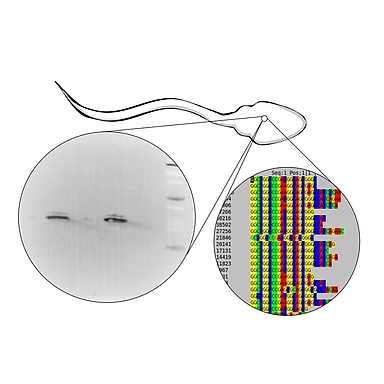Project 4.1

- PhD student: Darja Elzer
- Supervisor: Hans Zischler, Susanne Foitzik
- Co-Supervisors: René Ketting
- Further TAC-members: Peter Baumann
Our knowledge on reprogramming epigenome components especially small non-coding RNAs (sncRNAs), sperm nuclear protamines and residual histones is incomplete, especially in the context of their intergenerational transmission and thus evolutionary potential. I am looking for epigenetic information carriers that persist during reprogramming of the human male germline. To this end, I will analyze the epigenetic states of sperm nuclei by determining the sncRNA-patterns, and protamine and residual histone distribution in fully differentiated sperm cells.
The hypothesis of inheritance of acquired characters has recently been combined with classical Darwinian and genetic theories, forming a dual theory of genetic and epigenetic inheritance. While there is consensus on the possible consequences of the environment triggering an individual's health status, there is much debate about the possible inheritance of acquired characters via epigenetic mechanisms. To describe the phenomenon of epigenetic inheritance more precisely, the term "transgenerational" has been introduced to distinguish a non-sequence-based effect that is truly transmitted from one generation to the next from parental effects. Acquired traits can be written down in the epigenome of a cell, however, it is not entirely clear whether they can be transmitted from generation to generation via germ cells. This requires that epigenetic information carriers and possible changes of the epigenetic status are present or have been manifested in the germ cells. Our knowledge of the "germline reprogramming" of epigenome components such as small non-coding RNAs (sncRNAs) and residual sperm histones and protamines together with their modifications is lagging especially in terms of their evolutionary potential.
I will focus on two different epigenetic mechanisms and determine the respective epigenetic states of nuclei from fully differentiated human sperm. In the human male germ line, most histones are initially replaced by transition proteins and thereafter by protamines. I will examine the purified nuclei for residual histones and protamines located in the sperm head, their associated DNA-targets, and post-translational modifications. I plan to compare biological replicates with donors of different age groups.
Additionally, I will analyse sperm nuclear (nc)RNA that is either free or bound to proteins. In mammals, mRNA and ncRNA is massively eliminated during late spermatogenesis and post-testicular maturation of sperm. It is generally accepted that the oocyte carries the majority of regulatory relevant RNAs that function in the early embryo of most species. However, there is considerable and increasing evidence that sperm cells also carry functional RNA payloads. Theoretically, persistent small RNAs in the male germline can affect subsequent generations either directly via delivery to the zygote or indirectly by directing chromatin or DNA modifications during gametogenesis. Therefore, it is important to precisely describe the complete small RNA cargo of male gametes and to obtain experimental evidence related to the functions of small RNAs in the early embryo. I am checking for protein-associated fractions of small RNAs since an association with putative structural or effector proteins could represent circumstantial evidence functional relevance.